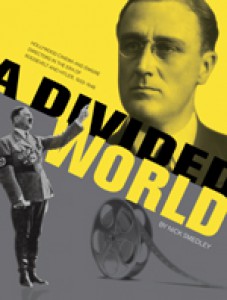A Divided World
Hollywood Cinema and Emigré Directors in the Era of Roosevelt and Hitler, 1933-1948
by Nick Smedley


Average rating: ![]()
| 0 | rating | |
| 0 | rating | |
| 0 | rating | |
| 0 | rating |
Your rating: -
Book Presentation:
The New Deal introduced sweeping social, political, and cultural change across the United States, which Hollywood embraced enthusiastically. Then, when the heady idealism of the 1930s was replaced by the paranoia of the postwar years, Hollywood became an easy target for the anticommunists. A Divided World examines some of the important programs of the New Deal and the subsequent response of the film community—especially in relation to social welfare, women’s rights, and international affairs. The book also provides an analysis of the major works of three European directors—Billy Wilder, Ernst Lubitsch, and Fritz Lang—compared and contrasted with the products of mainstream Hollywood. This is a new interpretation of an influential period in American film history and it is sure to generate further debate and scholarship.
Press Reviews:
“A well-researched, often intelligent survey of Hollywood cinema during and after Roosevelt’s presidency.”
Nigel Andrews | Financial Times
“Smedley, a British film historian, devotes A Divided World to an examination of Hollywood before, during, and immediately after World War II. According to Smedley’s overview, the American film colony warmly embraced FDR’s liberal idealism of the 1930s. But in the 1940s, when the New Deal came increasingly under attack from Republicans, Hollywood did not rally a liberal defense and instead responded with a cinema of alienation and anxiety. Yet within this community of mostly American-born directors, Smedley notes, there emerged a brilliant trio of émigrés—Ernst Lubitsch, Billy Wilder and Fritz Lang—who did not subscribe to the governing Hollywood approach. All three had worked in Berlin before the rise of the Third Reich. And all three made Hollywood films that were not only skillfully crafted but also profoundly different from the usual studio productions, “articulating criticisms of American society left unsaid by their contemporaries.”
Stefan Kanfer | Wall Street Journal
See the publisher website: Intellect Books
> From the same author:
Preston Sturges (2019)
The Last Years of Hollywood's First Writer-Director
by Nick Smedley and Tom Sturges
Subject: Director > Preston Sturges
The Roots of Modern Hollywood (2014)
The Persistence of Values in American Cinema, from the New Deal to the Present
by Nick Smedley
> On a related topic:
Stealing the Show (2016)
African American Performers and Audiences in 1930s Hollywood
Subject: Countries > United States
Transpacific Convergences (2022)
Race, Migration, and Japanese American Film Culture before World War II
by Denise Khor
Subject: Countries > United States
This Side of Despair (2008)
How the Movies and American Life Intersected during the Great Depression
Subject: Countries > United States
Vixens, Floozies and Molls (2005)
28 Actresses of Late 1920s and 1930s Hollywood
Subject: Countries > United States
Post-Classical Hollywood (2010)
Film Industry, Style and Ideology since 1945
Subject: Countries > United States
Destination London (2012)
German-Speaking Emigrés and British Cinema, 1925-1950
Dir. Tim Bergfelder and Christian Cargnelli
Subject: Countries > Great Britain